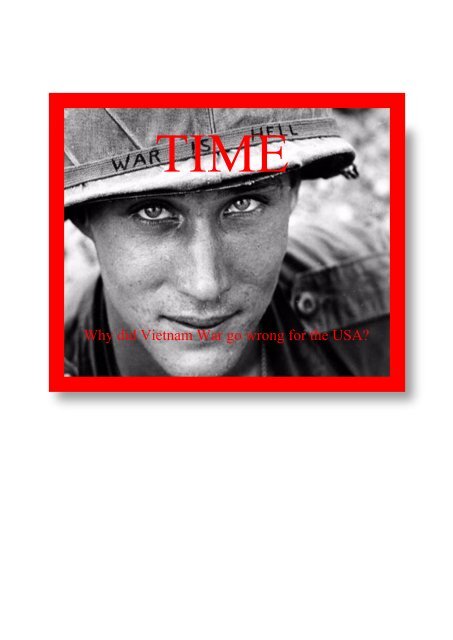Vietnam War: 42 years from the War
Vietnam War photo Essay on why the US has so
Vietnam War photo Essay on why the US has so
Create successful ePaper yourself
Turn your PDF publications into a flip-book with our unique Google optimized e-Paper software.
TIME<br />
Why did <strong>Vietnam</strong> <strong>War</strong> go wrong for <strong>the</strong> USA?
US and <strong>Vietnam</strong> troops resting in a forest near Binh gia, US soldiers exhausted and<br />
exasperated fighting in such unfamiliar terrain, in January 1965, whilst unbeknownst to much<br />
of <strong>the</strong> public.
USA, South <strong>Vietnam</strong> and o<strong>the</strong>r allied forces waiting to be deployed in <strong>Vietnam</strong> on <strong>the</strong> 8th of<br />
March, 1965. The US being overconfident after 2 successful implementations of <strong>the</strong><br />
Containment Policy. The fact that <strong>Vietnam</strong> being a poor South East Asian State, meant that it<br />
was not only going to be outnumbered but also outgunned, disillusioned <strong>the</strong> forces that it would<br />
be a quick and easy operation.
USA with advanced technology, most notable <strong>the</strong> UH-1A/B/C/D/E/F/H/L/M/P Iroquois<br />
"Huey", utility transport and gunship helicopter, which allowed for extreme mobility for<br />
search and destroy operations. This is also gave <strong>the</strong>m quick reaction which could have been<br />
used against <strong>the</strong> National Liberation Front’s (Viet Cong) Hit and Run Tactic.
A South <strong>Vietnam</strong>ese soldier kicking Viet Cong suspect. Since Vietcong had no official uniform<br />
nor identification and could hide among civilians or <strong>the</strong> local population, hence most of Viet<br />
Cong suspects were accused with little to no evidence, souring <strong>the</strong> support of <strong>the</strong> local<br />
population for <strong>the</strong> South <strong>Vietnam</strong>ese Democratic government as soldiers usually rely on brutal<br />
tactics to force suspects to confess
Soldiers waving at <strong>the</strong> Iroquois "Huey", utility transport and gunship helicopter, while a<br />
wounded soldier waits in pain for help to arrive. With increasing battles taking place in rough<br />
terrain such as forest or swamplands, battles on each side become increasingly costly. This<br />
negates <strong>the</strong> mobile advantage <strong>the</strong> US Soldiers have with helicopters, as in this terrain,<br />
issues with finding clearings to land safely, to evacuate or transport soldiers and supplies<br />
start arising.
A Tunnel Ferret staring down at a Viet Cong Tunnel with a flashlight and pistol in hand. “Tunnel<br />
Ferrets” were American, Australian and New Zealand soldiers who had been trained in Tunnel<br />
<strong>War</strong>fare where <strong>the</strong>y would navigate through <strong>the</strong> Viet Cong Tunnels, where <strong>the</strong> Viet Congs<br />
retreat to for hiding. However, this tunnels would usually stretch on far and wide and were<br />
usually laced with traps, and would’ve taken <strong>the</strong> soldiers days to finally cover every corner <strong>the</strong><br />
labyrinth underground.
Two soldiers of <strong>the</strong> 173rd Airborne Brigade in <strong>the</strong> clearing, wait for a medivac which will<br />
evacuate <strong>the</strong> body. As <strong>the</strong> war dragged on, <strong>the</strong> illusion that <strong>the</strong> war would be a quick and<br />
decisive battle slowly faded, as <strong>the</strong> war seemed to go on and on. A small anti-<strong>Vietnam</strong> war<br />
movement starts to ga<strong>the</strong>r momentum <strong>the</strong> longer <strong>the</strong> war dragged on.
A <strong>Vietnam</strong>ese litter-bearer passes <strong>the</strong> bodies of US and South <strong>Vietnam</strong>ese soldiers. American<br />
suffered lots of casualties in <strong>the</strong> hands of <strong>the</strong> Vietcong. It reached its peak in 1968, when<br />
roughly 16,000 troops lost <strong>the</strong>ir life in <strong>the</strong> year alone. Death toll of <strong>the</strong> <strong>Vietnam</strong> war increase<br />
exponentially. So did <strong>the</strong> American Movement to <strong>the</strong> end <strong>the</strong> war.
31 st January 1968, US and South <strong>Vietnam</strong>ese troops standing <strong>the</strong>ir ground against <strong>the</strong> Viet<br />
Cong during <strong>the</strong> Tet Offensive. This was a major shock to <strong>the</strong> US government and public as<br />
it showed that <strong>the</strong> Viet Cong were not as weak as previously claimed. This would <strong>the</strong>n go on<br />
to weaken domestic support as it proved that <strong>the</strong> end of <strong>the</strong> war was no where insight, and<br />
would spark many Anti-<strong>Vietnam</strong> <strong>War</strong> demonstrations. The most infamous being <strong>the</strong> Kent State<br />
University Demonstration which led to <strong>the</strong> death of 9 people when Police open fired on to <strong>the</strong><br />
crowd.
Upon being elected, U.S. President Richard Nixon introduced a new strategy called<br />
<strong>Vietnam</strong>ization that was aimed at ending American involvement in <strong>the</strong> <strong>Vietnam</strong> <strong>War</strong> by<br />
transferring all military responsibilities to South <strong>Vietnam</strong>. The increasingly unpopular war had<br />
created deep divisions in American society. Nixon believed his <strong>Vietnam</strong>ization strategy, which<br />
involved building up South <strong>Vietnam</strong>’s military strength in order to facilitate a gradual withdrawal<br />
of U.S. troops, would prepare <strong>the</strong> South <strong>Vietnam</strong>ese to take responsibility for <strong>the</strong>ir own<br />
defence against a Communist takeover and allow <strong>the</strong> U.S. to leave <strong>the</strong> conflict with its honour<br />
intact.
US soldiers packed up and ready to leave <strong>Vietnam</strong>. During <strong>the</strong> period of 12 Feb - 19 March<br />
1973, US troops began to withdraw <strong>from</strong> <strong>Vietnam</strong>, after Nixon took over as <strong>the</strong> President of<br />
US , and <strong>the</strong> truce between both sides were agreed upon during <strong>the</strong> Paris Peace Accord on<br />
January 27 1973, ending <strong>the</strong> <strong>Vietnam</strong> <strong>War</strong>. However, <strong>the</strong> government was fully aware with <strong>the</strong><br />
absence of <strong>the</strong> US in <strong>Vietnam</strong>, Saigon would one day fall into <strong>the</strong> hands of <strong>the</strong> Communism.





